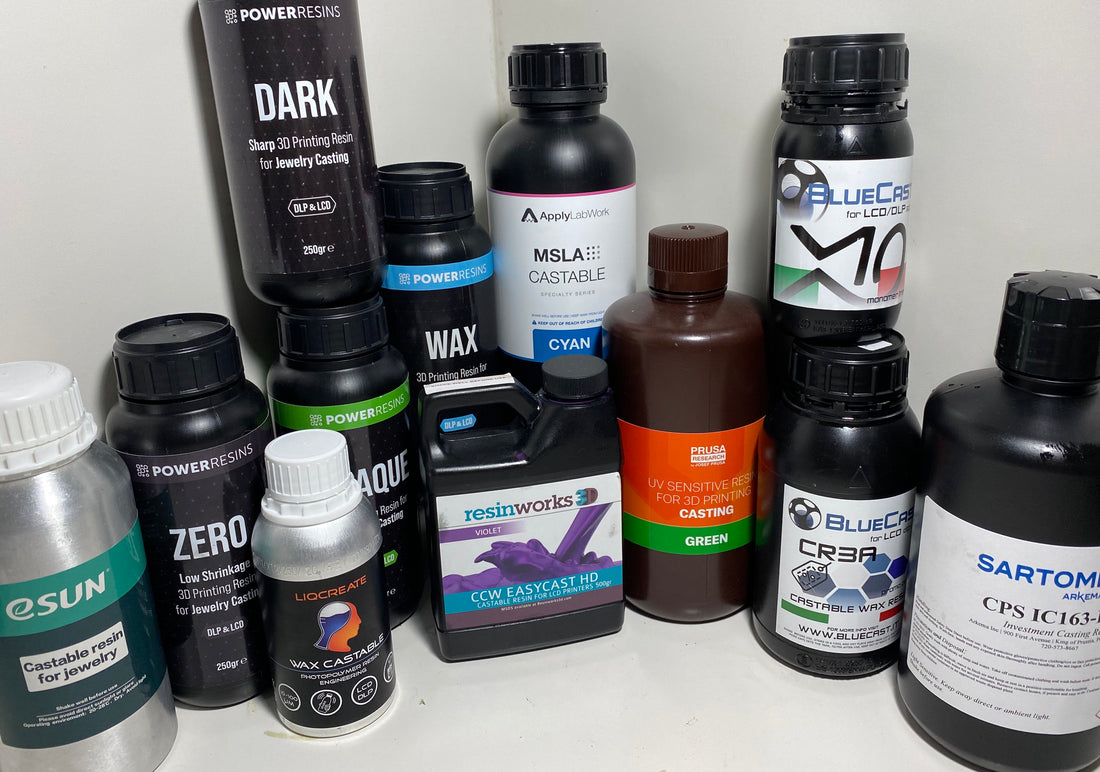Hello Everyone,
Shannon and I never expected to have had the opportunity to review so many castable resins when we first thought about getting into 3D printing and lost resin casting. We have learned a lot and felt that we should share this knowledge. We’ve chronicled our findings through our Youtube Channel but it’s gotten to the point where watching hours of videos isn’t realistic and a cliff notes version of which resin might suit your needs best needed to be created. We hope you find it useful.
We use a Prusa SL1 3D Printer for all of our testing, we realize that this isn’t the most popular printer on the market but our reasoning is thus: In the jewellery industry, as with many others the saying ‘Cheap Tools are Expensive Tools’ is generally true. What this means is if you buy the economy tool now for less, it will almost certain need replacing sooner rather than later, making it twice as expensive, and so the cycle continues. The SL1 fits neatly in the middle between $299 printers, and $10,000 printers offering an extremely well build case, great printing capability (less so these days), and open source design which will hopefully be upgradable in the future. We will see if the future is kind to our investment.
As of writing this we have tested 13 different castable resins, and have 4 more on the way. We run each resin through a variety of tests in terms of printability and castability. First using the recommended instructions and printer settings (if available) for each resin on a variety of models. The first is an array of hollow ball beads that test the resins ability to retain incredibly small structural detail. This model allows us to use a small amount of resin but still get as much information as possible from each print, it also helps dial in exposure times as the models have a target weight.
After a working exposure profile is found we shift focus slightly to casting and print a variety of models. Ranging from thin filigree web like designs, to heavy, thick (6mm+), texture heavy and completely smooth, various kinds of stone settings, etc. All of these still contribute to printability, but also casting later on down the line.


The most important, main casting equipment we use is as follows:
-4”x6” stainless vacuum flask
-Arbe Kaya Caster
-Kerr Electromelt 1KG (Ventura Melter from PepeTools now)
-Vigor Burnout Kiln running a standard 12 hour wax burnout schedule (unless explicitly mentioned)
-R&R Plasticast mixed 40/100 (with no additives unless explicitly mentioned)
Everything is priced within reason of and available to the average consumer, we do not use and disagree with using high end ($40,000+) Indutherm/Galloni/Yasui/etc overpressure vacuum casting equipment for our videos as we feel that it would skew the results away from viable, realistic expectations for the average person (and we can’t afford that shit…).
On the flip side, we choose not to use sand, cuttlefish bone or other kinds of casting that are lets be honest, antiquated, and aren’t the target use for this type of work.
Those with high end equipment are not likely printing with a budget category printer any way, and if they are, then great, all of this information will still apply and we hope they get amazing casting results.
We hope this information gets you started, or sets you further along in your jewellery journey.
If you need help with one of the resins on the list join our YouTube membership program or grab one of our 1:1 coaching spots from our online store.



3 comments
Hi there, I have been casting since 1979. I casted waxes for as long as I can remember golds and Platinum alloys all by torch..until 2004 when I had to purchase an induction casting machine for platinum given the volume of casting I was doing at the time.
I started casting resin( Envisiontek) in 2009 first generation and back then the best investment for resin was Ultravest Maxx that I still use from time to time.
I do not own a printer I only provide casting services for western Canada.Like you I cast numerous of different resins on the market pretty musch they are all similar especially the new generations of castable resins.I follow you on YouTube and thank you for the service that you offer by testing and reviewing all these different brands of resins. One thing I found, that when I reach 1350f as the top temperature of my burnout it does not work for me!! my castings are good only if I go over 1430f and hold for 4 hours!!It seems to me that it may work for wax but not for resin and this seems to be the problem with many of my collegues and others on line!! My kilns ( 4) areall calibrated annualy by a technician friend of mine..I use Prestige..Plasticast and Ultravest Maxx!! I am just very suprised by your burnout shared on YouTube!!and so are many people!! resin does not melt!! but it expands..700f does absoltely nothing to the resin instead 900f is a better choice..but you are using the same burnout as wax even though you said on line that resin is not wax so I am a bit confused by your burnout schedule..I tried and tried it and failed miserably every single time!! Thank you for reading and thank you for your services!!
Antonio Loy
How would you rank Sirya Tech Castable on this list?
Thank you very much for the content of your platforms.